|
Royal Bayreuth Porcelain:
An Obsessively Collectible Variety of Wares
| by Kat Thacker
Posted December 2013
|
 |
A brief overview for you: Royal Bayreuth (RB) is a truly unique, hard white-paste porcelain manufactured in Tettau, Germany, predominantly from 1795 through 1917. Several devastating fires experienced by the company during that time destroyed the factory, offices, molds and records which effectively stopped most of the manufacturing of their unique novelty wares (and exclusive finishes) exported around the world. Much of the information regarding their process was forever lost or too expensive to recreate at that point. Today's factory is still in operation but strictly manufacturing fine dinnerware.
|
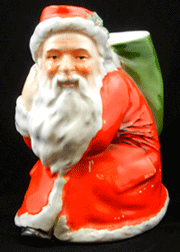
|
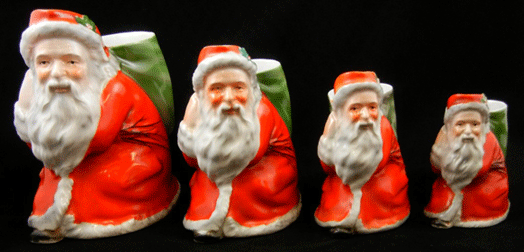
|
|
Figural red Santa lemonade with handle, rare, ca. 1875-1920, 7.25 inches tall, $6,500.
|
Red Santa grouping, pack as handle; a rare set: lemonade 7.25 inches,
water 6.25 inches, milk 5.25 inches, creamer 4 inches, ca. 1875-1920;
$2,000–$6,500 each depending on size.
|
The vintage novelty wares have always been the most highly collected. All are hand-painted; some have applied decals, metallic gold, silver or pearlized accents. They are found in hundreds of sizes, shapes, colors and patterns. There are three distinct finishes as well: linen (tapestry), satin (matte) or high gloss. There is no complete catalog available of all the varieties out there. With the advent of the internet, unknown versions frequently show up to surprise even veteran collectors. That's where the obsession comes into play. You just never know what you'll find in your ongoing search for this exquisite porcelain!
There are quite a few different marks to be found on RB. The earliest version was simply a blue cursive "T." It later evolved into a rampant lion holding a “T” shield. Between 1887 and 1902, both blue and green marks were used. After 1900, it further evolved into two rampant lions facing each other with shields, the words "Royal Bayreuth," "Bavaria" and "Priv. 1794" in a banner design. Colors of marks included blue, green and black. The marks were made via rubberstamps or decals found under the glaze. A few incised marks can also be found on exported pieces. Apparently, the marks continued to change slightly with each new director, but the dating became difficult as they tended to use whatever was on hand that day in the factory. Much of the actual documentation was destroyed by the previously mentioned factory fires.
|
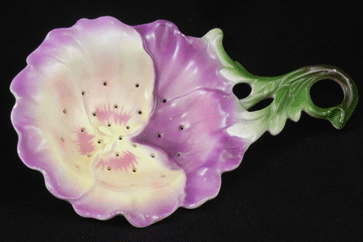
|
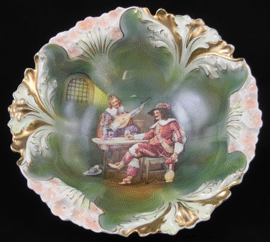
|
|
Figural tea strainer, Purple Pansy, ca. 1875-1920,
6 inches long, $350.
|
Scenic bowl – Musicians, ca. 1875-1920,
10.5 x 2 inches, $350.
|
The majority of RB collectors tend to concentrate on one variety mainly because of limited display space available. The figural variety is the most popular. They are particularly colorful and whimsical; the designers took naturalistic forms and turned them into utilitarian (but fanciful) shapes. The molds were very detailed and intricate, and came in multiple forms and sizes. Perhaps you've come across a giant red lobster water pitcher while antiquing and weren't aware that there were hundreds of other intriguing pieces to be found from this inventive company.
|
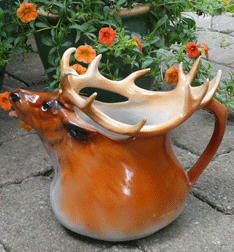
|
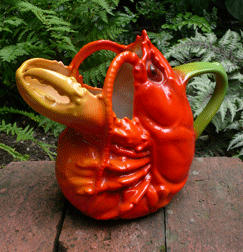
|
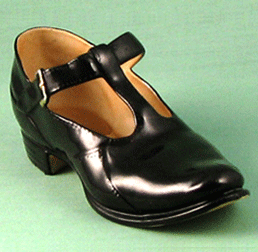
|
|
Figural elk water pitcher, ca. 1875-1920, 7 inches tall, $ 400.
|
Figural lobster water pitcher, ca. 1875-1920, 7 inches tall, $400.
|
Figural gloss T-strap shoe, rare, ca. 1875-1920, 4 inches long, $900.
|
In the figural variety, you can most easily find the lobsters and tomatoes. Additional figural shapes include shells, fruits, flowers and leaves. In the people forms, there is an Art Nouveau lady line, men and women characters, devils and the highly-collectible Santas. RB offers a huge variety of animals including ladybugs, snakes, turtles, roosters and platypuses, just to name a few. There are also animal-handled pieces. A huge group was created using the devil and card design. Undoubtedly created for use at card parties, this is one of the more masculine lines. The antlered elks have a definite "manly hunting lodge" feel to them as well. There are a huge variety of shoes (coveted by many collectors), multi-colored clowns and a sea-inspired Art Deco oyster and pearl variation.
|
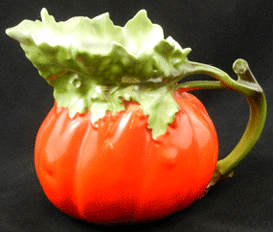
|
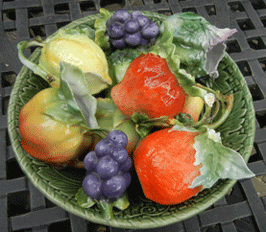
|
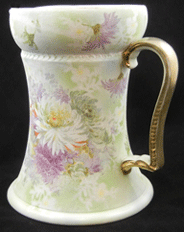
|
|
Figural tomato milk pitcher, ca. 1875-1920, 4.5 inches, $200.
|
Figural fruit grouping, ca. 1875-1920,
3-4.5 inches, $200–$450 per piece.
|
Chrysanthemum tapestry lemonade pitcher, corset shape, rare, 1875-1920,
8 inches tall, $1,500.
|
The classic series includes the Sunbonnet Babies, Nursery Rhymes, Snow Babies and Beach Babies. The Corinthian line (both limited and full-color) are unique, as are the yellow- and lime-colored Art Deco designs with penguins or storks. The scenics include more traditional Victorian decal images, as well as polar bears and humorous dancing frogs with bees on a burgundy ground. Some classic pieces are created in a unique tapestry finish that is textured like a woven fiber. A popular tapestry that some collect exclusively is the beautiful Rose Tapestry. They can be found in single colors (yellow, pink and silver) as well as multi-colored. Many of these are also found decorated with gold trim.
There are several great reference books available with thousands of photos to educate yourself, if you are interested in getting started. Mary McCaslin's ROYAL BAYREUTH A Collector's Guide (Books I and II) are the best for seeing the most variety. She does include a value/pricing guide in each. As with many collectibles, the market has been somewhat soft in the past few years, so you really need to do your homework to find more current values. The Internet has some information available, as do the Internet auction sites. A more recent book is Popular Royal Bayreuth For Collectors published in 2005 by Schiffer Books. It has large, detailed photographs of predominantly figural RB, as well as estimated values from mostly auction sources.
|
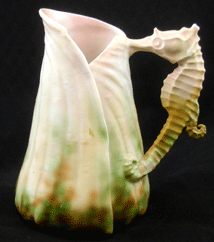
|
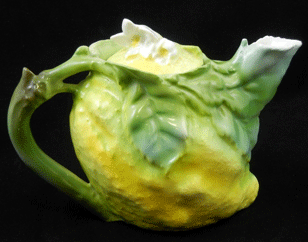
|
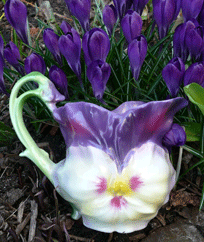
|
|
Figural shell with seahorse handle water pitcher, unusual, $1875-1920, 7.5 inches tall, $600.
|
Figural lemon teapot, ca.
1875-1920, 4.25 inches, $350.
|
Figural pansy creamer, ca. 1875-1920, 4 inches tall, $ 300.
|
Current rare items include larger-size water pitchers, lemonade pitchers, and chocolate pots which could sell for more than $5,000 each. Crossover collectibles are also in demand such as Santas, shoes, hatpin holders, and children's tea sets. Harder-to-find large figural items include squirrels, rabbits, turtles, ladybugs, chimps/apes, penguins, red devils, and Art Nouveau which may sell for a thousand dollars or more per piece. Miniature furniture is also difficult to find and could sell for $12,000-$18,000 a set.
|
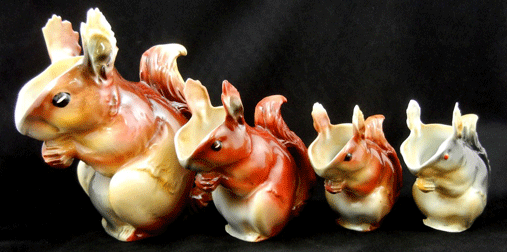
|
Figural Squirrel grouping, rare; lemonade 11 inches, Water 8 inches, Milk 5.5 inches, Creamer 4.75 inches, ca. 1875-1920, $1,000–$4,500 each, depending on size.
|
As with anything that has been sold for major dollars in the past, you will find some fakes out there. Anyone who has picked up a few genuine pieces will quickly learn the proper feel of RB. The weight and thickness of the porcelain and the finish of the paint have way more to do with authentication than does a proper mark. Many true RB pieces are not marked at all. There is sometimes confusion for the novice collector with several other manufacturers that were creating similar vintage novelty lines. Mitchell Woodbury & Co. (MW & Co.), Bohne, Schafer & Vater, and even some of the Czech porcelain creamers look similar. The more you actually see/touch/compare them, the easier it gets to authenticate the real thing.
A major advantage for collectors just starting out today is the fact that the prices are lower than in years past, and the Internet has made it easier to find some pieces. The many reference books and organizations (like the Royal Bayreuth Collectors Club) are now available for educating yourself further. Something else to keep in mind is that collectible RB is very fragile, manufactured for only a relatively short period, and earlier thought of as just novelty or souvenir ware. Some pieces are truly rare or still very difficult to find. The price fluctuation will undoubtedly slow down, increasing values down the road. Many pieces were never in great abundance and quite frankly, they aren't making them anymore. Most of the veteran collectors have seen prices rise and fall, but the unique nature of RB will make it always something to covet and treasure.
|
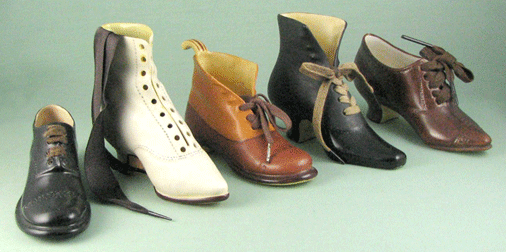
|
More Royal Bayreuth shoes.
|
If you're interested in finding out more, contact the Royal Bayreuth Collectors Club at the club website: www.RoyalBayreuth.org. You'll find informative links, lots of RB photos, and information on upcoming club events. The club publishes a quarterly newsletter, holds an annual convention, and has been educating collectors (both seasoned and beginners) since 1995. Dues are just $30 per year. You'll see more quality RB at the three-day conventions than you could possibly see searching for years on your own.
------------------------------
Kat Thacker is a freelance illustrator/designer living in the Detroit area. She has been a member of the Royal Bayreuth Collectors Club for 16 years and newsletter editor since 2006. Kat has been happily on her quest for Royal Bayreuth since 1985. Its color and whimsy make her smile every time she looks at it.
Bibliography:
McCaslin, Mary J. Royal Bayreuth: A Collector’s Guide, Marietta, Ohio: Antique Publications, 1994.
McCaslin, Mary J., Royal Bayreuth: A Collector’s Guide, Book II. Marietta, Ohio: Antique Publications, 2000.
Raines, Joan & Marvin. A Guide To Royal Bayreuth Figurals, Book I, New York/Self-published, 1973.
Raines, Joan & Marvin. A Guide To Royal Bayreuth Figurals, Book II. New York/Self-published, 1977.
Salley, Virginia Sutton and George H. Salley. Royal Bayreuth China. Privately printed, 1970.
|